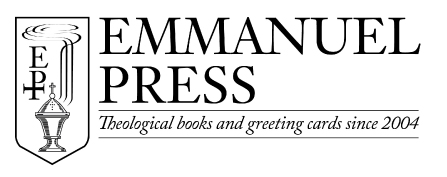Symposia Sale: All books up to 25% off
In honor of the annual Symposia at Concordia Theological Seminary in Fort Wayne next week, all of our books are on sale through Saturday, January 21! And if you’re planning to come, please note that there will not be an Emmanuel Press table at the Symposia next week, but you can place your order online and pick it up while you’re in town. (We’ll reimburse shipping.)
Explore our website by using the tabs above or the “word cloud” on the right sidebar. In addition, here are brief descriptions of each book:
*The Brotherhood Prayer Book (and CD) includes services for the day (Matins, Lauds, Prime, Terce, Sext, None, Vepsers, and Compline), the entire Psalter, daily and seasonal propers, and a Beichtspiegel unique to the BPB.
*Paul H.D. Lang’s Ceremony & Celebration gives a confessional apology for why the Lutheran Church is a liturgical church. It instructs in every aspect of the service, such as liturgical actions, liturgical space, and the church year. It explains why we do what we do.
*The Conduct of the Service describes what to do in the chancel, such as where to stand and how to move so that the emphasis remains on Christ and not on the liturgist.
*Prof. John Pless’s Didache uses the Bible, Luther’s Small Catechism, and the hymnal to instruct in a basic pattern of catechesis which expounds upon doctrine, liturgy, and vocation.
*An Explanation of the Common Service is an excellent supplement to Ceremony & Celebration in that it explains the actual words, or the rite, of the Divine Service. Read a review here.
*Liber Hymnorum: The Latin Hymns of the Lutheran Church is a collection of hymns taken exclusively from Lutheran hymnals and chant-books of the Reformation and post-Reformation era. It is two hymnals in one, the first half being English, the second Latin, exactly mirroring the first half in contents and numbering.
*The prayers in Wilhelm Loehe’s Seed Grains of Prayer contain collects for all occasions and are particularly good for personal devotion.
*Thy Kingdom Come and God With Us by Pr. David Petersen are books of sermons which are invaluable for homiletical ideas and for the devotional reading of good Law & Gospel sermons. In particular, Thy Kingdom Come offers over sixty sermons spanning Pre-Lent, all forty days of Lent, and the Sundays after Easter. Many customers find it to be an excellent daily devotion during Lent.
*What an Altar Guild Should Know gives details about church services, rubrics, altar care, sacred vessels, and other topics related to liturgical worship. However, anyone who is interested in liturgical worship will appreciate Lang’s keen theological insight into why reverence and beauty and the externals of worship matter.
In The Word Remains, Wilhelm Löhe gives insight into the confessional Lutheran understanding of the church year, the Word of God, and matters related to the Christian life.
Our newest Christmas card
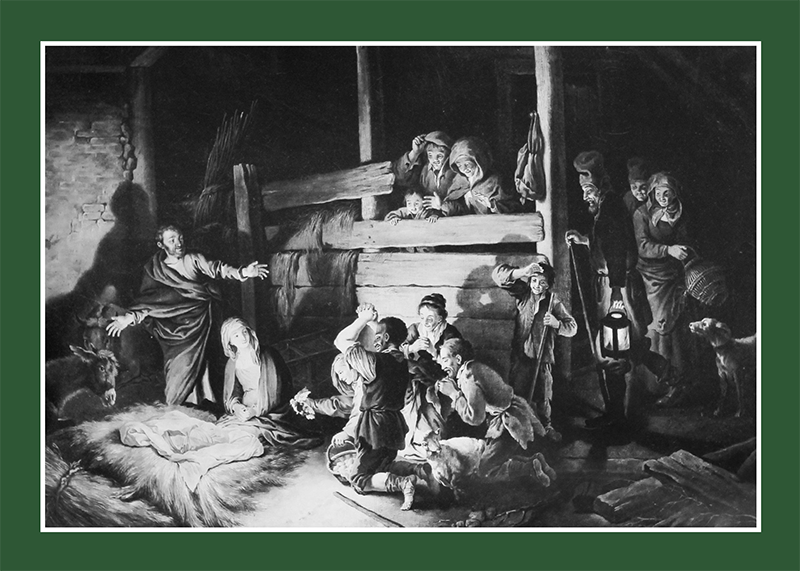
The Adoration of the Shepherds is an 18th-century oil painting by German artist C.W.E. Dietrich. Originally painted in color, our black and white version allows the light emanating from the infant Christ to shine within the darkness of the stable. The inside text proclaims: “Shepherds in the field abiding, watching o’er your flocks by night, God with us is now residing, yonder shines the infant light: Come and worship Christ, the newborn King!” (a verse from “Angels from the Realms of Glory”)
Visit our Christmas cards page to have a closer look at all 10 designs! New this year: you can now create a custom assortment of our unique Christmas cards to joyously confess our Savior’s birth.
Welcome, Listeners of Issues, Etc.!
 If you’ve found our website after hearing the commercial on Issues, Etc., we want to thank you for stopping by! Feel through to peruse the tabs above to learn more about our history and the books and greeting cards we offer. Several of our cards are pictured here; please visit our Christmas cards page for a closer look at all of the designs.
If you’ve found our website after hearing the commercial on Issues, Etc., we want to thank you for stopping by! Feel through to peruse the tabs above to learn more about our history and the books and greeting cards we offer. Several of our cards are pictured here; please visit our Christmas cards page for a closer look at all of the designs.
“The Holy Family” (left), an original painting by Lutheran artist Kelly Klages, is based on a beautiful 19th-century stained glass.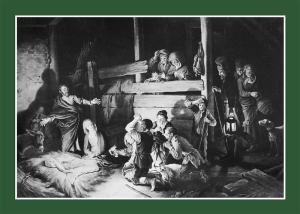
Our newest card, “The Adoration of the Shepherds” (right), is an 18th-century oil painting by German artist C.W.E. Dietrich. Originally painted in color, our black and white version allows the light emanating from the infant Christ to shine within the darkness of the stable.

In “Magnificat” (left), artist Meghan Schultz paired the depiction of Mary and Jesus (from “The Virgin of the Lilies” by 19th-century artist William-Adolphe Bouguereau) with hand-lettered words from the Song of Mary. She also added hand-drawn fleur-de-lis in the corners as a nod to Bouguereau’s French heritage and the lilies in his original piece, symbolic of Mary. The text inside features a verse from the beloved hymn, “Of the Father’s Love Begotten.”
 “Illumination” (left) is another original painting from Kelly Klages featuring the style of an illuminated manuscript with its decorated initial and elaborate border.
“Illumination” (left) is another original painting from Kelly Klages featuring the style of an illuminated manuscript with its decorated initial and elaborate border.
The artwork from “Nativity” (right) comes from the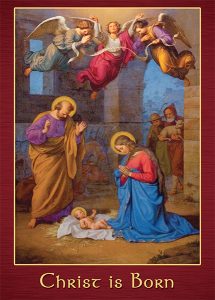 Imperial Cathedral of Speyer, Germany. These Nazarene-style frescos were painted in the cathedral’s interior walls in the mid-1800s by Johann von Schraudolph at the behest of King Ludwig I of Bavaria. The city of Speyer is significant in Reformation history; adherents of the Reformation were first called Protestants when they protested the Holy Roman Empire’s ban against Martin Luther and his teachings at an Imperial Diet in Speyer in 1529.
Imperial Cathedral of Speyer, Germany. These Nazarene-style frescos were painted in the cathedral’s interior walls in the mid-1800s by Johann von Schraudolph at the behest of King Ludwig I of Bavaria. The city of Speyer is significant in Reformation history; adherents of the Reformation were first called Protestants when they protested the Holy Roman Empire’s ban against Martin Luther and his teachings at an Imperial Diet in Speyer in 1529.
Thank you for visiting, and be sure to visit our Christmas cards page for a look at all of the cards and more details about the artwork.
Seed-Grains of Prayer: Longings for a Quiet and Peaceable Life
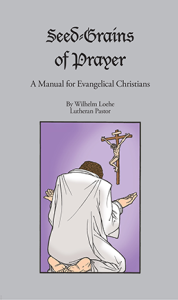 “Dear Lord, how miserably unreasonable it is that while the kingdoms of this world flourish and are sustained by the prayers of Thy Church, yet, at the same time, these do oppress and recklessly tread under foot Thy poor Church by whose prayers, faithfully offered, they are helped. For it is the Church alone, O God, whom Thou hast commanded to exercise care and diligence to pray for all in authority, as St. Paul has counseled (1 Timothy 2); and Thou hast so commanded because man needs peace, order, discipline, and safety to spread Thy Word, and by the Word to gather the Church. Grant, therefore, beloved Father, that under our government we may lead quiet and peaceable lives in all godliness and honesty, as may be well pleasing to Thee. Amen.”
“Dear Lord, how miserably unreasonable it is that while the kingdoms of this world flourish and are sustained by the prayers of Thy Church, yet, at the same time, these do oppress and recklessly tread under foot Thy poor Church by whose prayers, faithfully offered, they are helped. For it is the Church alone, O God, whom Thou hast commanded to exercise care and diligence to pray for all in authority, as St. Paul has counseled (1 Timothy 2); and Thou hast so commanded because man needs peace, order, discipline, and safety to spread Thy Word, and by the Word to gather the Church. Grant, therefore, beloved Father, that under our government we may lead quiet and peaceable lives in all godliness and honesty, as may be well pleasing to Thee. Amen.”
Wilhelm Loehe in Seed Grains of Prayer, #242
What resources are there to learn Gregorian chant?
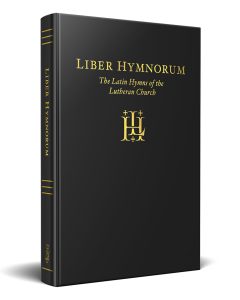 More from our interview with editor and translator Matthew Carver: “Basic instruction in Gregorian chant was not in view in this volume for a couple reasons: there are already great resources for it, and Liber Hymnorum was envisioned as a sort of supplement to other Lutheran chant resources already in use. That being said, anyone who knows how to read modern notation can use the music in the English section as a basis for learning all the Latin hymns and chants without knowledge of Gregorian chant, since they are (with few exceptions) largely the same, despite their different looks. So to keep down the size and price of the volume while simultaneously providing as many of these hymns and chants as possible, I’ve left instruction in Gregorian chant to others.
More from our interview with editor and translator Matthew Carver: “Basic instruction in Gregorian chant was not in view in this volume for a couple reasons: there are already great resources for it, and Liber Hymnorum was envisioned as a sort of supplement to other Lutheran chant resources already in use. That being said, anyone who knows how to read modern notation can use the music in the English section as a basis for learning all the Latin hymns and chants without knowledge of Gregorian chant, since they are (with few exceptions) largely the same, despite their different looks. So to keep down the size and price of the volume while simultaneously providing as many of these hymns and chants as possible, I’ve left instruction in Gregorian chant to others.
“First, if you have The Brotherhood Prayer Book and its accompanying CD, you already have a good introduction to Gregorian chant that will give you all you need to sing from the Latin section of Liber Hymnorum. (A Liber Hymnorum CD is also in the works!) There are several online resources, too, such as “An Idiot’s Guide to Square Notes” and the Corpus Christi Watershed site, which includes instruction and audio examples in How to Read and Sing Gregorian Chant. There is an active group on Facebook called “Gregorian Chant is for Everyone” as well as a group devoted to The Brotherhood Prayer Book (“Lutheran Liturgical Prayer Brotherhood”), where questions concerning chant can be answered. In short, there is little to keep people from learning to sing from Gregorian notation—in fact, once you get the basics from one of these resources, you find it really is simpler, more flexible, and more forgiving than standard modern notation!
“As far as Latin pronunciation is concerned, we’ve normalized the old Reformation-period spelling so that it can be pronounced according to the classical method or the Roman or German ecclesiastical (church Latin) method, though for the sake of rhyme the latter is preferred. Some instructions in pronouncing churchly Latin can be found here, and there is a good comparative table in the Wikipedia article “Latin regional pronunciation.” Students of Latin may find it best to use the accent familiar to them from their curriculum. In any case, when singing with others, it is wise to agree on the method of pronunciation beforehand!”
Pr. Rob Paul reviews Liber Hymnorum
 “Liber Hymnorum is yet another example of Mr. Matthew Carver’s ability and propensity to deliver to our generation the great, lost treasures of the Evangelical Lutheran Church’s past. Mr. Carver and Emmanuel Press have done the churches and schools of the Church a great service by editing and publishing such a fine volume of hymns.
“Liber Hymnorum is yet another example of Mr. Matthew Carver’s ability and propensity to deliver to our generation the great, lost treasures of the Evangelical Lutheran Church’s past. Mr. Carver and Emmanuel Press have done the churches and schools of the Church a great service by editing and publishing such a fine volume of hymns.
“The Liber consists of a significant introduction, two sections of hymns, and significant indices for hymn enthusiasts and scholars alike. The introduction details not only the contents and thought behind the volume, but also provides significant information about the hymns and hymn books of the early Lutheran Church. Each hymn comes from the Lutheran books of the sixteenth and seventeenth centuries. Here readers are introduced to the names of Lucas Lossius and Matthäus Ludecus, among others. Liber Hymnorum promises to provide not only a wealth of resources for the scholar of Lutheran hymnody and Latin hymnody, but also a useful volume for the classical schools, choirs, teachers, and pastors of our Church.
“With regards to the hymnal itself, first, there are English hymns for use during the week, the Church Year, for feasts and festivals, and for general and seasonal use. Second, the same hymns are presented in their original Latin texts. The English portion of the hymnal provides the tunes of the hymns in modern music notation. This provides a level of accessibility to these hymns of the Church that has not existed before. Many hymns will be new; however, some popular favorites are represented in this volume (In Dulci Jubilo, “Lord Keep Us Steadfast in Your Word,” “Creator of the Stars of Night,” and “Savior of the Nations Come,” among others). The Liber also exposes the Church to the wide breadth of hymns written for specific times and occasions that have been hidden from the Church’s use for so long.
“In the Latin portion, these hymns are presented in Gregorian notation. Since the same hymns are presented in modern music notation earlier in the hymnal, these tones are now more accessible for the musically inclined. One thing that is lacking is an explanation of neumes – that is, Gregorian notation – or at least references that direct novices towards more material if they are interested. The Brotherhood Prayer Book is referenced in the introduction, and it contains such material. But for use in schools, if pastors and teachers wish to educate on Gregorian notation, a supplement to this hymnal is necessary.
“Finally, the indices provide novices and scholars alike with resources concerning the tones used throughout the hymnal. The indices also contain comprehensive lists of the authors, composers, and sources contained in the book.
“Liber Hymnorum looks to be a volume worthy of any classical Lutheran school, Latin student, music student, Lutheran pastor or musician, or even the avid layperson. What once was inaccessible to most is now available to many in a great and friendly format. The Liber is a useable hymnal with great potential. It is my hope that classical Lutheran schools, church youth and adult choirs, pastors and laity alike will take advantage of this resource in order to better understand and embrace the rich heritage Lutherans have in the Latin hymnody presented in Liber Hymnorum.”
-Rev. Robert W. Paul, Pastor and Headmaster, Immanuel Lutheran Church and School, Roswell, NM; Board Member of the Consortium for Classical Lutheran Education (CCLE)
*In our next post, Matthew Carver will answer the question, “What resources are there to help learn Gregorian chant?” Like us on Facebook or sign up for email updates on the right sidebar.
Pless endorses The Word Remains by Wilhelm Löhe
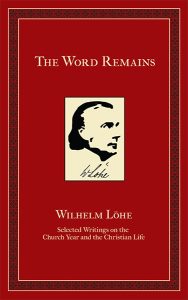 “Wilhelm Loehe (1808-1872) was one of the church fathers of the 19th century, to use the description of Hermann Sasse. His pastoral wisdom combined with a zeal for Lutheran missions marked Loehe’s life and work. In this collection, the voice of Pastor Loehe speaks across the years into our own time and place. Insightful, brief commentaries on the days and seasons of the church year along with pithy sayings on the Christian life will provide readers with much to kindle their hearts and minds for meditation and prayer. This is a devotional classic which will continue to edify and enlighten both pastors and laity.” -Prof John T. Pless
“Wilhelm Loehe (1808-1872) was one of the church fathers of the 19th century, to use the description of Hermann Sasse. His pastoral wisdom combined with a zeal for Lutheran missions marked Loehe’s life and work. In this collection, the voice of Pastor Loehe speaks across the years into our own time and place. Insightful, brief commentaries on the days and seasons of the church year along with pithy sayings on the Christian life will provide readers with much to kindle their hearts and minds for meditation and prayer. This is a devotional classic which will continue to edify and enlighten both pastors and laity.” -Prof John T. Pless
*Purchase The Word Remains along with Liber Hymnorum: The Latin Hymns of the Lutheran Church — and save 10% on both!
A quick note about purchasing Liber Hymnorum
Today we received word from our printer that Liber Hymnorum is ready! We’re heading to Ohio tomorrow to pick up the books so that we can have them available at the “Lutheranism and the Classics” conference in Fort Wayne. This has really been down to the wire, but we are thrilled that we can debut Liber Hymnorum with author Matthew Carver in person. The book will be released on this website on Friday, September 30. If you want to know when the page is live, like us on Facebook or sign up for email updates on the right sidebar.
How would Liber Hymnorum be used devotionally?
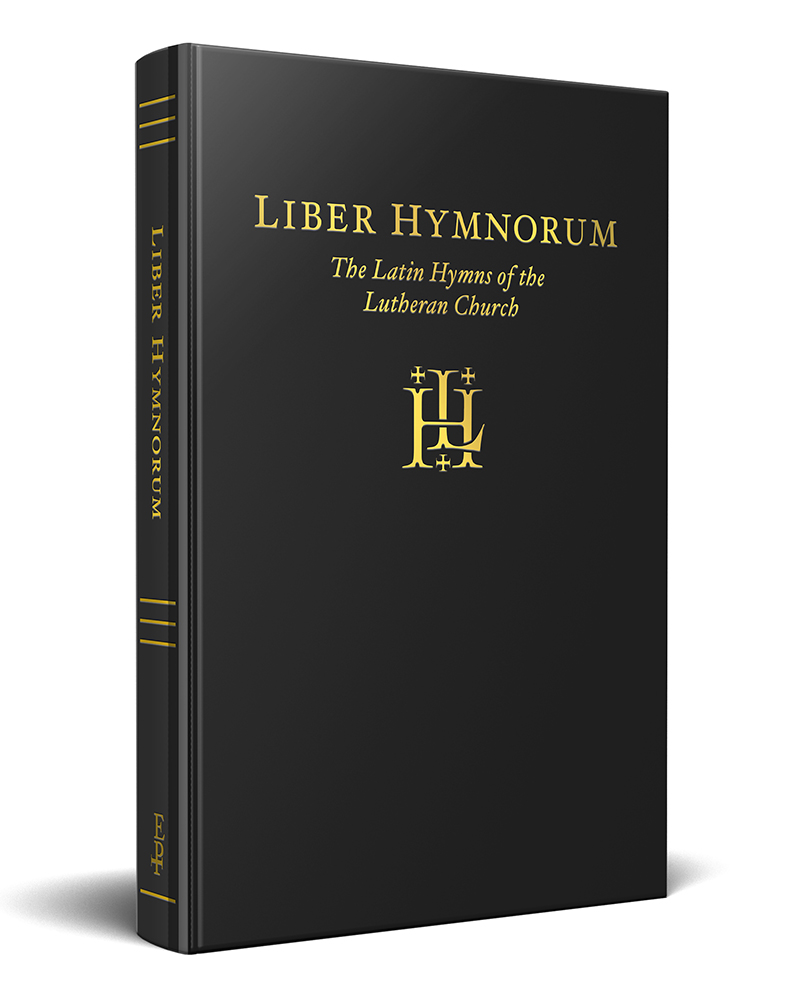 “Liber Hymnorum is arranged according to the church year, with the ‘de tempore’ (times and seasons) in the front and ‘de sancto’ (saints and festivals) in the back of each section. This makes use in home or church fairly simple and straightforward. Christians, through these hymns, find expression for their own spiritual sentiments in response to God’s gifts each hour and day and reflect on the themes of the season or feast, tying in with what happens at church. The prayer service hymns (hymns of the daily office, or Liturgy of the Hours) especially can and should be used by Christians at home as well as in those churches where Matins and Vespers are offered. A regular course and use of these ancient hymns anchors the mind and heart to the hours, days, seasons, and all time as God arranges it.
“Liber Hymnorum is arranged according to the church year, with the ‘de tempore’ (times and seasons) in the front and ‘de sancto’ (saints and festivals) in the back of each section. This makes use in home or church fairly simple and straightforward. Christians, through these hymns, find expression for their own spiritual sentiments in response to God’s gifts each hour and day and reflect on the themes of the season or feast, tying in with what happens at church. The prayer service hymns (hymns of the daily office, or Liturgy of the Hours) especially can and should be used by Christians at home as well as in those churches where Matins and Vespers are offered. A regular course and use of these ancient hymns anchors the mind and heart to the hours, days, seasons, and all time as God arranges it.
“The melodies are given in standard notation (resembling the stemless chants found in our modern hymnals) as well as the original Gregorian notation. For those able to read Gregorian notation (a worthy endeavor; not as hard as it looks!), the Latin hymns are completely underlaid, so there is no guesswork in which syllable goes on which note, leaving the mind freer to contemplate the spiritual depths of the text (or at least, to grasp the basic meaning of the Latin!).”
–Matthew Carver: author, editor, and translator
More details about Liber Hymnorum
 We are still finalizing the release date for Liber Hymnorum, but we do have a few more details to share. It is a hardcover book, 342 pages, 6″ x 9″, selling for $35.00.
We are still finalizing the release date for Liber Hymnorum, but we do have a few more details to share. It is a hardcover book, 342 pages, 6″ x 9″, selling for $35.00.
Over the course of the next week, we plan to provide excerpts, more of the interview with author Matthew Carver, and additional endorsements. Today, we offer you his answer to our question regarding the translation and settings:
“The translation came about mainly in two ways. First, since most of the ancient hymns for the prayer services were unchanged when Lutherans incorporated them into their hymnals, I took a similar approach and used the familiar translations we have of those hymns, written by some of the great poets and translators of the 19th and 20th century, such as Edward Caswall, J. D. Chambers, and J. M. Neale. Above all, I tried, where possible, to use those translations which are familiar to Lutherans (and Christians generally) through books such as the English Hymnal and The Brotherhood Prayer Book. At the same time, some of the collection represents an alteration or accommodation to pure Lutheran doctrine. For these, I started with the familiar translations and tweaked those parts which the Lutherans had tweaked, which were not many, to be fair, since the majority of the most ancient hymns appointed for use in the church are doctrinally pure. Additionally, there are several Reformation-period hymns written in Latin by the learned poets and teachers of the day, such as Philip Melanchthon. These were composed to ancient meters and set to ancient melodies (the only new melody here is that for the Latin version of Luther’s “Erhalt uns Herr bei deinem Wort”). And while some of these have been translated into German and from German into English, they have not, before now, been translated directly into English verse to be sung to the same melody. These Reformation-period hymns are thus presented here for the first time for church and devotional use.”
